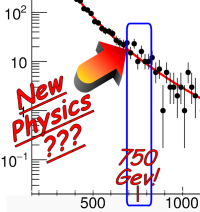 To the dismay of physics geeks everywhere, theoretical particle physics struck out at the plate this year. Three swings, three misses. (Well, maybe one wasn’t really a swing. More a taken ball the umpire called a strike.) It was a crushing disappointment for those of us hoping for a rule-change to the game.
To the dismay of physics geeks everywhere, theoretical particle physics struck out at the plate this year. Three swings, three misses. (Well, maybe one wasn’t really a swing. More a taken ball the umpire called a strike.) It was a crushing disappointment for those of us hoping for a rule-change to the game.
On the other hand, cosmology geeks got three recent home runs, so there was victory (with more coming!) for those who peer at the big and distant. On the other other hand, none of those were game-changers either. (They were just, you know, awesome.)
Since I follow both physics and cosmology, win some, lose some.
This post is about the strike out, so I’ll just list the three homers, two by NASA and one by the LIGO team.
[In fact, I’ve blogged about two of them. See Gravity Waved (LIGO) as well as Pluto (the planet)! and Pluto Presents! and Plutonic Star Tar! Yeah, I did get a bit excited about Pluto!]
For the record:
- NASA sent New Horizons to Pluto (and beyond!)
- NASA also sent the ion-propelled Dawn to Vesta and Ceres
- LIGO detected gravity waves (predicted by Einstein)
All good stuff (great stuff!), even if none of it is a game-changer.
 If NASA ever finds aliens, or even just signs of life, that will be a game-changer. Sort of.
If NASA ever finds aliens, or even just signs of life, that will be a game-changer. Sort of.
As we expected to find the Higgs boson, we pretty much expect to find some sort of life.
Be more shocking if we don’t!
I suspect we’ll not find intelligent life, though. Maybe not complex life, or even multi-cell life, but we’ll see.
[I wrote a post last August, BB #46: We’re the Ancestors!, that suggested humanity may have arrived on the scene pretty early in the universe’s eventual full history. I’ve been seeing news stories recently about how scientists are now starting to think the same thing. Remember, you read it here first!]
§
 On the Yang side, the diphoton bump that appeared at CERN in the 2015 data for both CMS and ATLAS has vanished in the 2016 data.
On the Yang side, the diphoton bump that appeared at CERN in the 2015 data for both CMS and ATLAS has vanished in the 2016 data.
See Jester’s post, A new boson at 750 GeV?, on Résonaances, or Matt Strassler’s post, So What Is It???, on Of Particular Significance, for the announcement of the bump.
See their respective followup posts, After the hangover and The 2016 Data Kills The Two-Photon Bump, for the let-down.
That’s a huuuuge disappointment. Had the bump turned out to be a real signal, it would mean a new particle — new physics, something we’ve been seeking for about 50 years.
Back in the 1960s, Gell-Mann’s quark model, as well as the Higgs model, defined the last two pieces of the Standard Model of physics. The top quark, the last to be found, was seen in 1995.
And, of course, we finally saw the Higgs boson (or a Higgs boson) last year. With that, the Standard Model is complete, both in theory and, at long last, observation.
But we know for sure that there’s no way both quantum physics and general relativity are complete models (let alone accurate descriptions of reality rather than just models that work). They don’t fit together, and that begs a resolution. So far, we only have ideas!

This is the data that got everyone so excited. There is an unexpected bump at the 750 Gev point. The black dots are data, the red line is the expected values. The lower plot flattens out the upper one to highlight the bump.
Speculative physics: Supersymmetry. Certain aspects of particle physics work better if all the fundamental particles we’ve found in the Standard Model also have supersymmetric partner particles. But so far we haven’t found any, and each new experiment closes the window a little further.
Physicists who work on supersymmetry are running out of models to test!
Real physics: One bit of nice news. Looks like researchers at CERN’s LHCb experiment found evidence of a pentaquark! That’s kinda cool (but not new physics).
§
 The second strikeout came with the announcement by researchers at LUX (Large Underground Xenon experiment) that, having completed their experiment, no dark matter particles had been found by their detector, which was the most sensitive made so far.
The second strikeout came with the announcement by researchers at LUX (Large Underground Xenon experiment) that, having completed their experiment, no dark matter particles had been found by their detector, which was the most sensitive made so far.
While this doesn’t mean the dark matter particles don’t exist, it does tighten the constraints on where they might yet exist.
As with supersymmetry, we’re starting to run out of places to look!
And, since dark matter particles aren’t part of the Standard Model, finding such a particle would also mean new physics!
This, along with LIGO spotting black holes, seems to be reviving interest in the idea of black holes, or MACHOS (MAssive Compact Halo Objects), as the source of the dark matter that’s making galaxies spin faster than they should if they were made totally of ordinary matter.
On the other hand, various cosmological observations are narrowing the window on what sizes those might be. (If they were within certain size ranges, we would have spotted them by now.)
§
 And most recently, the IceCube researchers in the Antarctic released that they find no evidence of sterile neutrinos.
And most recently, the IceCube researchers in the Antarctic released that they find no evidence of sterile neutrinos.
They believe their data is sufficient to essentially rule out the existence of such a particle.
Neutrinos are weird matter particles (but part of the SM) that only interact with matter via the weak force (and gravity, of course). They have no charge and very little mass.
Sterile neutrinos are even more elusive because they don’t interact with the weak force.
Finding them would mean, you guessed it, new physics, since they aren’t really called out in the Standard Model. They’re thought to possibly be right-handed neutrinos which are potentially accounted for through observations of other right-handed fermions.
Strike Three!
§
 So three swings, three misses. Although the diphoton bump wasn’t really a swing, as such. Unlike the Higgs (but like the Spanish Inquisition), no one expected it, no one was looking for it. It was just noticed in the data.
So three swings, three misses. Although the diphoton bump wasn’t really a swing, as such. Unlike the Higgs (but like the Spanish Inquisition), no one expected it, no one was looking for it. It was just noticed in the data.
We continue to explore outwards, Mars, Venus, Mercury, Vesta, Ceres, Jupiter, Saturn, Pluto,… so much exploration there.
We likely will return to the Moon, mine the asteroid belt, and live on Mars, all in the fairly new future.
But we seem stymied by the very small, the quantum world.
Ironically, it seems to fit the general mode of humanity. We look and explore outwards with such force and vigor, but we don’t seem to direct quite so much energy looking inwards or reflectively.
Wouldn’t it be interesting if learning to look inwards ourselves led us to insights about the quantum nature of reality? Yes, fanciful imagining, but it is kind of weird how outward and upward are our natures!
Stay quantum, my friends!













August 13th, 2016 at 2:10 pm
That Standard Model just won’t admit it’s wrong. Could it even be right after all? Dark matter needs to step up, because it’s starting to look like the weak link.
August 13th, 2016 at 2:40 pm
Yeah! And General Relativity is just as stubborn. I don’t hear as much talk about “beyond GR” as I do BSM. (And I think I’ve expressed my personal desire for GR to “win.”) I think it might be because GR doesn’t present the conundrums the SM does. Why (only) three families? Why the masses and coupling constants? Why the huge difference in strength between the three forces? Why did matter win over anti-matter? Is the wave function real? What does it mean for it to collapse? Which of the many interpretations of the SM is best?
I could go on. Seems like the SM raises more questions than it answers. (Plus it’s fucking weird!)
I’ve always thought there was a tinge of epicycles to the SM. I side with Albert on this one (and pretty much every other opinion he had; definitely a fan).
That oddball idea that we live in a VR seems to be gaining steam. I’ve heard it from numerous sources now. It would account for the physics weirdness as well as the nagging anthropic problem.
A Greg Egan book I read gave me an idea that reality could be both “virtual” and naturally occurring, although it requires a Tegmarkian view. But if reality, including its inhabitants, is successfully modeled as a sequence of computational states, and if that sequence still works “from the inside” even if re-arranged in time, then any correct sequence of otherwise random states in the greater universe would equal that reality.
Imagine cutting a bunch of movies into individual frames of film and throwing them into a mixed up pile — which appears to be a random collection of disconnected moments with no connection to nearby moments. But each film still exists in the pile and can, in theory, be re-assembled. From the point of view of the characters in the movie, their reality seems as it ever was: the movie.
Imagine if actual underlying reality was just a vast sea of quantum white noise. But within that noise can be found states that model an infinite number of realities. All that matters is the states. Any given state might reflect a tiny slice of any number of realities.
Thus we get many worlds and multi-universe ideas in one and account for any weirdness or disconnect in our theories: that’s just what this reality’s rules turned out to be.
August 14th, 2016 at 5:09 am
I suspect that Albert wouldn’t have had much time for multiverses and arbitrary constants. He liked his physics to be deterministic.
My view is that while we can’t rule out VR or infinite numbers of arbitrary universes, these represent philosophical straw-clutching because of a failure to make significant headway in past decades. Even if physics can be arbitrary, we still need to explain the mechanism by which our particular universe acquired its very specific laws, constants, couplings, etc.
The quantum noise theory holds some attraction for me. Then the laws of physics would emerge from nothing. Indeed, where else might they come from?
August 14th, 2016 at 4:27 pm
Yeah, same here. Not a fan of multi-verse theories (nor even of MWI). Are you familiar with Lee Smolin’s theory about how black holes give birth to new universes with slightly modified laws from the current one. This process began in some random universe that allowed at least one black hole to form, which created a new universe with laws allowing more BHs.
Essentially, Smolin’s got an evolutionary cosmology theory involving BHs evolving towards universe types most friendly to the creation of BHs. The theory is from his first book in 1997, The Life of the Cosmos. Not sure if he still believes in the theory.
At least it provides an explanation of how the constants became what they are. They are what is best for a universe in which BHs can form. And, incidentally, beings like us. Mostly it means a universe in which massive stars can form; the rest kinda comes with.
My question has been: In what physical framework does this BH evolution take place in? What are its laws? I have the same issue with the Big Bang. Some set of physical laws and some sort of physical framework had to exist to foment the BB.
These theories all seem more metaphysical than physical. Generally impossible to test. But the “fine-tuning” sure seems to beg an explanation.
I like the analogy of a lottery ticket. When millions are made and sold, it’s not at all surprising that someone gets a winning ticket (i.e. an inhabitable universe). But imagine only ever printing one ticket and having that one ticket happen to be the winner! It boggles the mind.
Our universe seems to be a winning lottery ticket. The only way that’s not mega-weird is if (a) someone or something made this universe or (b) there’s gillions of losing lottery tickets out there, too.
The trouble with (a) is that the question just moves up to their level, then! As with the easy answer: God created the universe! Okay… who or what created God? (And if God “just always was” so, too, can be the universe, and we’re still left pondering why. Existence is a really vexing damn question!)
August 15th, 2016 at 3:51 am
Yes. More data needed.
Although … when I sit and stare at the symmetries and constants in the standard model and let my mind float out to encompass GR, it feels like there is a really simple explanation just out of reach. I wonder if all we need is a genius like Einstein or Feynman to explain it all to us in a really simple way.
August 15th, 2016 at 9:31 am
Could be. Could be.
It sure is disheartening that so many people over so many decades have made such little progress.
August 23rd, 2016 at 4:20 am
This has potential I think. It tries to link QM to gravity, explain QM, resolve quantum entanglement (which is a massive clue to a unified theory IMO), and also preserves einstein’s equations. Win-win-win-win.
https://www.sciencenews.org/blog/context/new-einstein-equation-wormholes-quantum-gravity
August 23rd, 2016 at 2:16 pm
Yeah, I noticed it’s been making the rounds lately. One news site does a story and often many others are inspired to write a similar one for their readers.
It’s fun watching the waves of stories ripple through the feed. Another one lately is that experiment with water flowing down a drain such that it simulates a “black hole” but for sound rather than light. The experimenters confirmed the equivalent of Hawking radiation occurs in the water-based model. The real fun is seeing how different organizations write the headline!
ER=EPR has been around a few years. Speculative physics, but something new sure is needed! Here’s a Wiki article, and one of these days I’ll get around to watching this:
Susskind is a good lecturer. I have a bunch of his GR lectures queued up, but haven’t gotten around to listening to them.